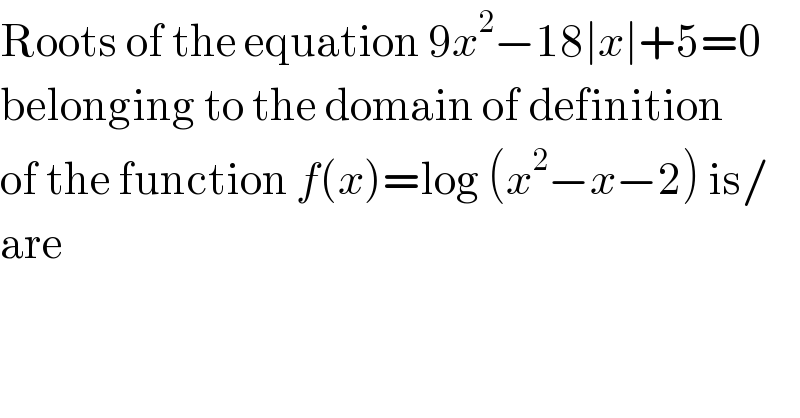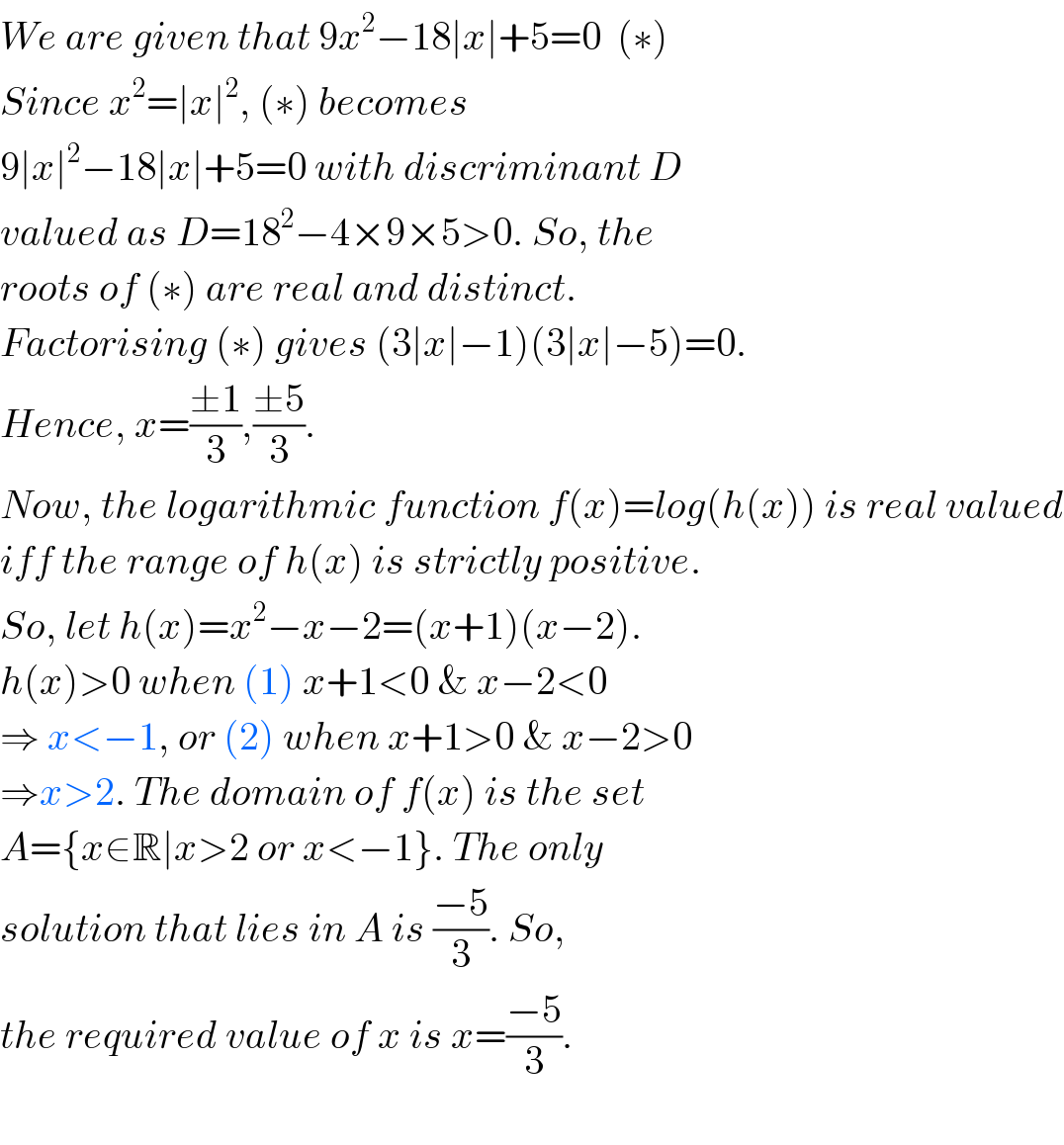
Question Number 4882 by Rishabh Jain last updated on 19/Mar/16

$$\mathrm{Roots}\:\mathrm{of}\:\mathrm{the}\:\mathrm{equation}\:\mathrm{9}{x}^{\mathrm{2}} −\mathrm{18}\mid{x}\mid+\mathrm{5}=\mathrm{0} \\ $$$$\mathrm{belonging}\:\mathrm{to}\:\mathrm{the}\:\mathrm{domain}\:\mathrm{of}\:\mathrm{definition} \\ $$$$\mathrm{of}\:\mathrm{the}\:\mathrm{function}\:{f}\left({x}\right)=\mathrm{log}\:\left({x}^{\mathrm{2}} −{x}−\mathrm{2}\right)\:\mathrm{is}/ \\ $$$$\mathrm{are} \\ $$
Answered by Yozzii last updated on 19/Mar/16

$${We}\:{are}\:{given}\:{that}\:\mathrm{9}{x}^{\mathrm{2}} −\mathrm{18}\mid{x}\mid+\mathrm{5}=\mathrm{0}\:\:\left(\ast\right) \\ $$$${Since}\:{x}^{\mathrm{2}} =\mid{x}\mid^{\mathrm{2}} ,\:\left(\ast\right)\:{becomes} \\ $$$$\mathrm{9}\mid{x}\mid^{\mathrm{2}} −\mathrm{18}\mid{x}\mid+\mathrm{5}=\mathrm{0}\:{with}\:{discriminant}\:{D} \\ $$$${valued}\:{as}\:{D}=\mathrm{18}^{\mathrm{2}} −\mathrm{4}×\mathrm{9}×\mathrm{5}>\mathrm{0}.\:{So},\:{the} \\ $$$${roots}\:{of}\:\left(\ast\right)\:{are}\:{real}\:{and}\:{distinct}.\: \\ $$$${Factorising}\:\left(\ast\right)\:{gives}\:\left(\mathrm{3}\mid{x}\mid−\mathrm{1}\right)\left(\mathrm{3}\mid{x}\mid−\mathrm{5}\right)=\mathrm{0}. \\ $$$${Hence},\:{x}=\frac{\pm\mathrm{1}}{\mathrm{3}},\frac{\pm\mathrm{5}}{\mathrm{3}}. \\ $$$${Now},\:{the}\:{logarithmic}\:{function}\:{f}\left({x}\right)={log}\left({h}\left({x}\right)\right)\:{is}\:{real}\:{valued} \\ $$$${iff}\:{the}\:{range}\:{of}\:{h}\left({x}\right)\:{is}\:{strictly}\:{positive}. \\ $$$${So},\:{let}\:{h}\left({x}\right)={x}^{\mathrm{2}} −{x}−\mathrm{2}=\left({x}+\mathrm{1}\right)\left({x}−\mathrm{2}\right). \\ $$$${h}\left({x}\right)>\mathrm{0}\:{when}\:\left(\mathrm{1}\right)\:{x}+\mathrm{1}<\mathrm{0}\:\&\:{x}−\mathrm{2}<\mathrm{0} \\ $$$$\Rightarrow\:{x}<−\mathrm{1},\:{or}\:\left(\mathrm{2}\right)\:{when}\:{x}+\mathrm{1}>\mathrm{0}\:\&\:{x}−\mathrm{2}>\mathrm{0} \\ $$$$\Rightarrow{x}>\mathrm{2}.\:{The}\:{domain}\:{of}\:{f}\left({x}\right)\:{is}\:{the}\:{set} \\ $$$${A}=\left\{{x}\in\mathbb{R}\mid{x}>\mathrm{2}\:{or}\:{x}<−\mathrm{1}\right\}.\:{The}\:{only}\: \\ $$$${solution}\:{that}\:{lies}\:{in}\:{A}\:{is}\:\frac{−\mathrm{5}}{\mathrm{3}}.\:{So}, \\ $$$${the}\:{required}\:{value}\:{of}\:{x}\:{is}\:{x}=\frac{−\mathrm{5}}{\mathrm{3}}. \\ $$$$ \\ $$
